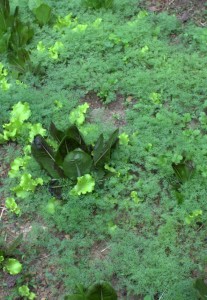In the garden dill has re-seeded itself. Right now the hundreds of miniature dill plants look like a fuzzy carpet of light green.

Some of the dill will be used to make pickles in the summertime. Some will be given away to other pickle makers. Some will be used fresh in the kitchen and some will be dried. We crop off the plants that are growing in awkward places first just to be frugal about it.
Cilantro is another herb that regularly re-seeds itself. We find its little sprouts all around the stone walkway near the herbs bed.
We let a few favorite lettuce plants go to seed on purpose. That way we can collect seed to share and so we know we’ll always have some. It only takes a little effort to do it, so why not?
Herbs and garden plants typically annuals, meaning they grow and produce their crops in one year’s time. We buy small plants at nurseries and markets to transplant in our gardens.
The transplants were given a head start by spending their young life in the warmth of a greenhouse. They’ll be a few inches tall by the time seeds at ambient temperatures will be sprouting.
By growing transplants we can extend the growing season by getting fruit earlier than what would naturally be produced. Some plants don’t need lots of heat to make produce for us though, things like herbs that reseed and lettuce greens. Their season is much shorter to crop than say tomatoes or peppers.
Re-seeding is letting nature take its course. We by-pass saving seeds and just let them drop to the ground. When they’re dry enough or mature enough, the seeds will sprout given the right circumstances. Moisture is usually involved. No tending necessary!